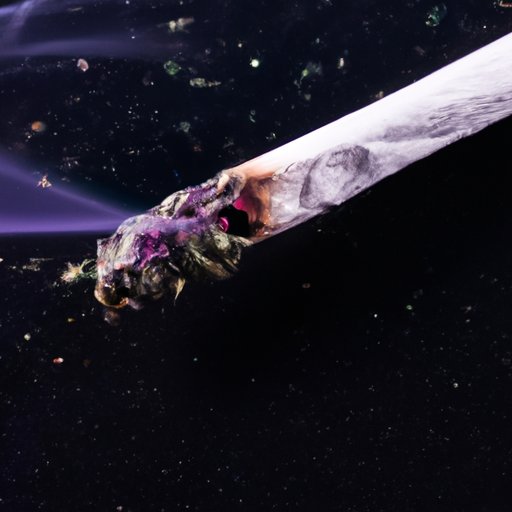
I. Introduction
Have you ever wondered if you can get high just from being in the same room as people who are smoking or vaping? This phenomenon is known as contact high, and it’s a topic of interest for many people. In this article, we’ll explore the science behind it, the potential risks, legal implications, myths, and ways to avoid it. Whether you are a non-smoker, concerned parent, or curious individual, understanding contact high is essential.
II. Exploring the Science of Getting Contact High: What the Research Says
Several scientific studies have explored this topic, and the results are mixed. The primary factor that determines whether someone can get high from secondhand smoke or vapor is the concentration of the substance in the air. THC (tetrahydrocannabinol), the main psychoactive component in cannabis, can be detected in the blood of non-smokers who have been exposed to high concentrations of smoke for prolonged periods. However, the amount of THC they absorb is typically only a fraction of what a regular smoker would get.
The same applies to vaping, where the e-liquid’s concentration and heat source are crucial factors in determining exposure. Additionally, factors such as room size and air ventilation significantly influence the concentration of vapor and smoke in the air. Therefore, it’s unlikely to get high from casual exposure to smoke or vapor.

III. The Risks of Getting Contact High
While getting contact high might be improbable, it’s important to understand the risks involved. Secondhand smoke or vapor can cause several health issues, including respiratory problems, headaches, nausea, and eye irritation. Prolonged exposure to smoke and vapor can also lead to long-term health effects, such as lung cancer, heart disease, and stroke, among others.
Moreover, THC can impair cognitive functioning and cause temporary mental and physical side effects in non-smokers who are exposed to high concentrations of smoke or vapor. In some extreme cases, such exposure can cause hallucinations, paranoia, and other adverse symptoms.
IV. The Legal Implications of Getting Contact High
Getting contact high can have several legal implications, especially if you’re in a region or state where cannabis is illegal or strictly regulated. For example, if you’re driving and get pulled over by a law enforcement officer who suspects you’re under the influence of drugs, you might end up facing DUI (driving under the influence) charges, even if you didn’t smoke or vape yourself.
Additionally, smoking or vaping cannabis in public spaces where it’s prohibited can result in legal charges, and in some states, landlords can evict tenants who smoke on their properties. Therefore, it’s essential to be aware of the legal implications of getting contact high and the rules in your locality.
V. Debunking Myths About Getting Contact High
There are several myths and misconceptions about getting contact high, such as the notion that you can get high from inhaling secondhand smoke or vapor. While it’s true that exposure to high concentrations of smoke or vapor can lead to absorption of THC, it’s not significant enough to cause a high or register positive on a drug test.
Another common myth is that holding your breath or wearing a mask can protect you from cannabis smoke or vapor. While these measures can reduce exposure, they’re not entirely effective, and other factors such as room ventilation and distance from the source of smoke or vapor also play a role.
Finally, there’s the misconception that getting contact high is a harmless and fun experience. It’s essential to understand the risks involved, both in terms of health and legal implications, and avoid taking the phenomenon lightly.
VI. A Guide to Avoiding Contact High
While it’s challenging to entirely avoid exposure to secondhand smoke or vapor, several strategies can minimize the risks. For example, if you’re in a social setting where people are smoking or vaping, try to stay away from the source of smoke or vapor, and ensure there’s adequate ventilation in the room. If you’re a non-smoker or concerned parent, it’s also vital to communicate your concerns to those around you.
Other practical measures include wearing a mask or investing in air purifiers or filtration systems. Additionally, avoiding exposure to smoke or vapor in the first place is the best way to prevent contact high. If you’re in a state or region where cannabis is illegal or regulated, it’s vital to follow the laws and regulations and avoid putting yourself in risky situations.
VII. The Social Dynamics of Getting Contact High
Getting contact high is not just a matter of science and health; it’s also a social phenomenon that’s shaped by various factors. For example, many people might feel pressure to smoke or vape in social settings, even if they don’t want to. Additionally, cultural norms and social circles play a role in how contact high is perceived and discussed.
For instance, in some cultures, smoking cannabis is accepted, and getting contact high might be viewed as a normal social experience, while in others, it’s considered taboo. Understanding the social dynamics surrounding contact high is crucial in navigating social situations and making informed decisions.
VIII. Conclusion
In conclusion, getting contact high is a complex phenomenon that involves scientific, health, legal, and social factors. While it’s unlikely to get high from casual exposure to smoke or vapor, there are still risks involved, and it’s crucial to be aware of the potential health and legal implications. Debunking myths and misconceptions is essential in promoting a better understanding of contact high, and embracing practical strategies to avoid exposure is the smartest approach. By understanding the science, risks, and social dynamics of getting contact high, you’re better equipped to make informed decisions and protect yourself and others.





